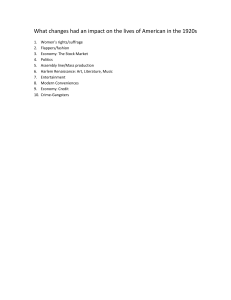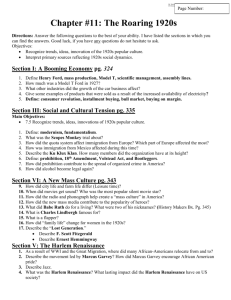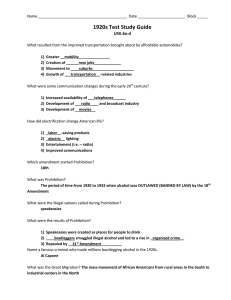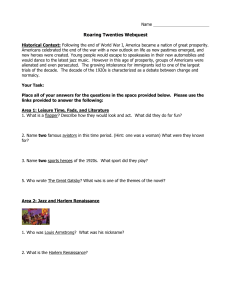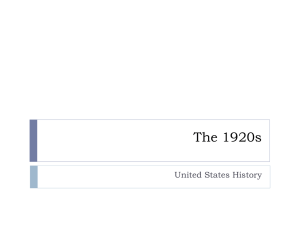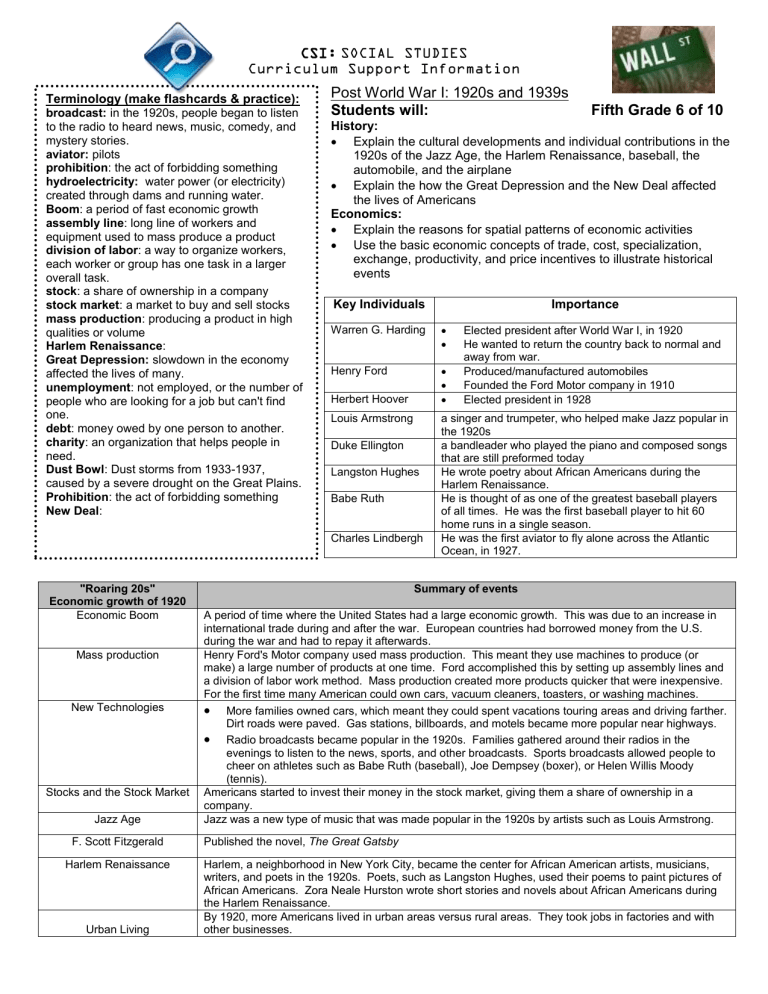
CSI: SOCIAL STUDIES Curriculum Support Information Terminology (make flashcards & practice): broadcast: in the 1920s, people began to listen to the radio to heard news, music, comedy, and mystery stories. aviator: pilots prohibition: the act of forbidding something hydroelectricity: water power (or electricity) created through dams and running water. Boom: a period of fast economic growth assembly line: long line of workers and equipment used to mass produce a product division of labor: a way to organize workers, each worker or group has one task in a larger overall task. stock: a share of ownership in a company stock market: a market to buy and sell stocks mass production: producing a product in high qualities or volume Harlem Renaissance: Great Depression: slowdown in the economy affected the lives of many. unemployment: not employed, or the number of people who are looking for a job but can't find one. debt: money owed by one person to another. charity: an organization that helps people in need. Dust Bowl: Dust storms from 1933-1937, caused by a severe drought on the Great Plains. Prohibition: the act of forbidding something New Deal: Post World War I: 1920s and 1939s Students will: Key Individuals Mass production New Technologies Stocks and the Stock Market Jazz Age F. Scott Fitzgerald Harlem Renaissance Urban Living Importance Warren G. Harding Henry Ford Herbert Hoover Louis Armstrong Duke Ellington Langston Hughes Babe Ruth Charles Lindbergh "Roaring 20s" Economic growth of 1920 Economic Boom Fifth Grade 6 of 10 History: Explain the cultural developments and individual contributions in the 1920s of the Jazz Age, the Harlem Renaissance, baseball, the automobile, and the airplane Explain the how the Great Depression and the New Deal affected the lives of Americans Economics: Explain the reasons for spatial patterns of economic activities Use the basic economic concepts of trade, cost, specialization, exchange, productivity, and price incentives to illustrate historical events Elected president after World War I, in 1920 He wanted to return the country back to normal and away from war. Produced/manufactured automobiles Founded the Ford Motor company in 1910 Elected president in 1928 a singer and trumpeter, who helped make Jazz popular in the 1920s a bandleader who played the piano and composed songs that are still preformed today He wrote poetry about African Americans during the Harlem Renaissance. He is thought of as one of the greatest baseball players of all times. He was the first baseball player to hit 60 home runs in a single season. He was the first aviator to fly alone across the Atlantic Ocean, in 1927. Summary of events A period of time where the United States had a large economic growth. This was due to an increase in international trade during and after the war. European countries had borrowed money from the U.S. during the war and had to repay it afterwards. Henry Ford's Motor company used mass production. This meant they use machines to produce (or make) a large number of products at one time. Ford accomplished this by setting up assembly lines and a division of labor work method. Mass production created more products quicker that were inexpensive. For the first time many American could own cars, vacuum cleaners, toasters, or washing machines. More families owned cars, which meant they could spent vacations touring areas and driving farther. Dirt roads were paved. Gas stations, billboards, and motels became more popular near highways. Radio broadcasts became popular in the 1920s. Families gathered around their radios in the evenings to listen to the news, sports, and other broadcasts. Sports broadcasts allowed people to cheer on athletes such as Babe Ruth (baseball), Joe Dempsey (boxer), or Helen Willis Moody (tennis). Americans started to invest their money in the stock market, giving them a share of ownership in a company. Jazz was a new type of music that was made popular in the 1920s by artists such as Louis Armstrong. Published the novel, The Great Gatsby Harlem, a neighborhood in New York City, became the center for African American artists, musicians, writers, and poets in the 1920s. Poets, such as Langston Hughes, used their poems to paint pictures of African Americans. Zora Neale Hurston wrote short stories and novels about African Americans during the Harlem Renaissance. By 1920, more Americans lived in urban areas versus rural areas. They took jobs in factories and with other businesses. 19th Amendment Problems in the 1920s Discrimination Prohibition Decreased need for farming 1930 Electricity The 19th amendment was ratified, giving women the right to vote. Summary of events Women, African Americans, Asian Americans, Mexican Americans, and immigrants still faced prejudice. The Ku Klux Klan (KKK) spread hatred against anyone they thought of as "un-American". The 18th amendment was ratified and made the selling and drinking of alcoholic beverages against the law in the U.S. People who produced and sold alcohol were considered criminals during this prohibition era. This was later repealed (or ended) by the 21st amendment in 1933. Farmers grew and sold large numbers of crops during WWI but after the war the government didn't have a great need for a large number of crops, so prices dropped. Many farmers couldn't earn enough money to pay back loans and were forced into urban jobs. Summary of events In 1920, about 35% of houses had electricity. By 1930, 70% of houses had electricity. culture May artists expressed the suffering of the Great Depression through photographs, music, and writing. Margaret Mitchell A writer from Atlanta, wrote the famous novel, Gone with the Wind. In 1939, it was made into a movie. Jesse Owens A track star, who won four gold medals in the 1936 Olympics. He inspired many Americans to achieve their best. Great Depression 1929 - 1940 Stock market crash of 1929 Economic slowed down Causes Dust Bowl Soup kitchens Summary of events In October 1929, the stock market crashed. This means the total value of all stocks fell very quickly and were no longer worth much money. Many people lost a lot (or all) of their money. When the stock market crashed, people felt less confident in the economy. They bought less goods, causing store owners to order less goods. This meant that factories had to fire employees because they couldn't make enough money to pay them. The number of people who were unemployed continue to rise. This cycle continued to spiral sending us into a time period called the Great Depression. People were in debt, from loans they took out during the Roaring 20s People could no longer afford to buy new goods bank failures, during the 1930s many banks went out of business Massive dust storms from 1933 - 1937 were seen across the Great Plains due to a severe drought. Thousands of farming families had to move to other places, such as California, to look for work on ranches and in orchards. Many Mexican families were forced to move back to Mexico during this time. Charities and religious groups donated free meals to the hungry. People who did not have money for food lined up at soup kitchens and formed bread lines to wait for free food. New Deal Franklin Roosevelt Civilian Conservation Corps (CCC) Works Progress Administration (WPA) Tennessee Valley Authority (TVA) Social Security Minimum Wage Summary of events Became president in 1932 started a variety of new programs that became known as the New Deal to give people food, shelter, work, etc. Its goal was to create jobs and conserve (or protect) the natural environment. People who worked for the CCC planted trees, completed conservation projects, and cleared hiking trails. WPA hired people to build streets, parks, libraries, and schools. This program also paid artist to paint murals on public buildings and hired authors to write books about different placed throughout the U.S. TVA workers built dams on the Tennessee River. These dams were used to create hydroelectricity for rural areas in the Southeast. This program is still seen today. It provides money to people over the age of 65, as well as to people who have disabilities and can't work. This is the lowest amount of money a worker can get paid.


